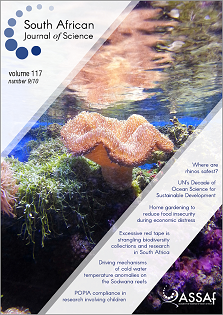Estimating lightning NOx production over South Africa
DOI:
https://doi.org/10.17159/sajs.2021/8035Keywords:
Lightning Detection Network, lightning flash density, nitrogen oxides, EDGAR, lightning NOxAbstract
Nitrogen oxides (NOx = NO + NO2) are toxic air pollutants and play a significant role in tropospheric chemistry. Global NOx hotspots are the industrialised regions of the USA, Europe, Middle East, East Asia and eastern parts of South Africa. Lightning is one of the many natural and anthropogenic sources of NOx to the troposphere. It plays a role in the formation of particulate matter and tropospheric ozone, which are both linked to harmful health and climate effects. The discourse on NOx over the southern African continent has mainly focused on anthropogenic sources. However, lightning is known to be a main source of tropospheric NOx globally. It is therefore important to understand its contribution to the national and global NOx budget. Data from the South African Lightning Detection Network were used to approximate the influence of lightning on the NOx load over the country, and to develop a gridded data set of lightning-produced NOx (LNOx) emissions for the period 2008 2015. The Network monitors cloud-toground lightning strikes; and theoretically has a detection efficiency of 90% and a location accuracy of 0.5 km. An emission factor of 11.5 kg NO2/flash was employed to calculate the LNOx budget of ~270 kt NO2/year. The calculated LNOx was 14% of the total NOx emission estimates published in the EDGAR v4.2 data set for the year 2008. The LNOx emission inventory will improve model performance and prediction, and enhance the understanding of the contribution of lightning to ambient NO2.
- The results show that both lightning and industrial NOx sources are essential in evaluating NOx and tropospheric O3 chemistry over South Africa. As a result they should both be considered in air quality modelling, to assist in air quality management planning.
- LNOx emissions are projected to increase with climate change, which may lead to an increase in tropospheric O3. Thus it is important to have an LNOx inventory, to be used as input into air quality modelling, as it will improve model performance and forecasting, and the understanding of the sensitivity of ambient pollution to changes in lightning emission.
- It will further inform chemical transport modelling so that the contribution of both natural and anthropogenic sources can be better understood.
Published
Issue
Section
License

This work is licensed under a Creative Commons Attribution 4.0 International License.

All articles are published under a Creative Commons Attribution 4.0 International Licence
Copyright is retained by the authors. Readers are welcome to reproduce, share and adapt the content without permission provided the source is attributed.
Disclaimer: The publisher and editors accept no responsibility for statements made by the authors
How to Cite
- Abstract 958
- PDF 822
- EPUB 172
- XML 167












.png)